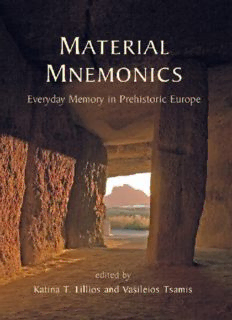
Material Mnemonics: Everyday Memory in Prehistoric Europe PDF
Preview Material Mnemonics: Everyday Memory in Prehistoric Europe
Material Mnemonics Material Mnemonics Everyday Memory in Prehistoric Europe edited by Katina T. Lillios and Vasileios Tsamis OXBOW BOOKS Oxford and Oakville Published by Oxbow Books, Oxford, UK © Oxbow Books and the individual authors, 2010 ISBN 978-1-84217-966-6 Th is book is available direct from: Oxbow Books, Oxford, UK (Phone: 01865-241249; Fax: 01865-794449) and Th e David Brown Book Company PO Box 511, Oakville, CT 06779, USA (Phone: 860-945-9329; Fax: 860-945-9468) or from our website www.oxbowbooks.com Front cover: View of La Peña de los Enamorados from the rear of the Menga dolmen (Antequera, Malaga, Spain) on the summer solstice of 2007 at 0712 hours. Photograph by Javier Pérez González. Courtesy of the Ministry of Culture, Andalusian Government Back cover: Reconstruction of storage room 9 from Assiros building phase 9 (circa 1360BC). Image created by Richard Potter A CIP record of this book is available from the British Library Library of Congress Cataloging-in-Publication Data Material mnemonics : everyday memory in prehistoric Europe / edited by Katina T. Lillios and Vasileios Tsamis. p. cm. Includes bibliographical references. ISBN 978-1-84217-966-6 (pbk.) 1. Prehistoric peoples--Europe. 2. Social archaeology--Europe. 3. Anthropology, Prehistoric--Europe. 4. Memory--Social aspects--Europe. 5. Mnemonics--Social aspects--Europe. 6. Antiquities, Prehistoric-- Europe. I. Lillios, Katina T., 1960- II. Tsamis, Vasileios. GN803.M38 2010 153.1’40936--dc22 2010029645 Printed and bound in Great Britain by Hobbs the Printers Ltd, Totton, Hampshire Table of Contents List of contributors vii 1. Introduction 1 Katina T. Lillios and Vasileios Tsamis 2. Natural substances, landscape forms, symbols and funerary monuments: Elements of cultural memory among the Neolithic and Copper Age societies of southern Spain 10 Leonardo García Sanjuán and David W. Wheatley 3. Mnemonic practices of the Iberian Neolithic: Th e production and use of the engraved slate plaque-relics 40 Katina T. Lillios 4. Th e art of memory: Personal ornaments in Copper Age South-East Italy 73 Robin Skeates 5. Burning matters: Memory, violence and monumentality in the British Neolithic 85 Andrew Jones 6. Layers of memory: An embodied approach to the Late Bronze Age of Central Macedonia, Greece 103 Vasileios Tsamis 7. Memory, landscape, and body in Bronze Age Denmark 123 Janet E. Levy 8. Memory maps: Th e mnemonics of central European Iron Age burial mounds 147 Bettina Arnold 9. Memories of features, memories in fi nds. Th e remembrance of the past in Iron Age Scandinavia 174 Lars Larsson 10. Re-collecting the fragments: Archaeology as mnemonic practice 188 Yannis Hamilakis List of contributors Bettina Arnold Janet E. Levy Department of Anthropology Department of Anthropology University of Wisconsin-Milwaukee University of North Carolina-Charlotte 290 Sabin Hall Charlotte, North Carolina 28223 USA P.O. Box 413 3413 N. Downer Ave Katina T. Lillios Milwaukee, Wisconsin 53201 USA Department of Anthropology 114 Macbride Hall Leonardo García Sanjuán University of Iowa Departamento de Prehistoria y Arqueologia Iowa City, Iowa 52242 USA Universidad de Sevilla Sevilla, Spain Robin Skeates Department of Archaeology Yannis Hamilakis Durham University Department of Archaeology South Road University of Southampton Durham, DH1 3LE, UK Avenue Campus Highfi eld Vasileios Tsamis Southampton, SO17 1BF, UK Wessex Archaeology Ltd Portway House Andrew Jones Old Sarum Park Department of Archaeology Salisbury, SP4 6EB, UK University of Southampton Avenue Campus David Wheatley Highfi eld Department of Archaeology Southampton, SO17 1BF, UK University of Southampton Avenue Campus Lars Larsson Highfi eld Department of Archaeology and Ancient Southampton, SO17 1BF, UK History Lund University Box 117 SE-221 00 Lund, Sweden 1 Introduction Katina T. Lillios and Vasileios Tsamis Beginning in the 1990s, archaeologists and other scholars of material culture increasingly turned their attention to memory and devoted themselves to identifying and analyzing memory practices, memory sites, and material mnemonics (Alcock 2002; Bradley 2002; Buchli and Lucas 2001; Forty and Küchler 1999; Hallam and Hockey 2001; Jones 2007; Mills and Walker 2008; Radstone 2000; Saunders 2003; Van Dyke and Alcock 2003; Williams 2003). Th is mnemophilia is likely related to and dependent on emerging intellectual currents in the study of agency, biography, time, nationalism, and identity politics. Whether memory studies remain a theoretical horizon – broadly experienced but short-lived – or mature to become part of a more enduring phase in the evolution of archaeological theory and practice is, however, unknown. Writing about memory is to open a Pandora’s Box of further possibilities. To avoid a lengthy and generalised discussion of the subject, we wish to briefl y consider those writers and their works that have infl uenced today’s archaeologies of memory, specifi cally in the ways they articulate everyday memory, the collective, place, and the senses. Th ese writers include Halbwachs (1992[1925]), Bachelard (1964), Casey (1987), Nora (1989), and Connerton (1989). Th e works of Maurice Halbwachs focus on two main lines of research. Th e fi rst is social classes, in particular, the working class (e.g. in terms of consumption, housing, and life styles), and the second is the role of memory in a program of collective psychology. Halbwachs criticizes scholars who consider memory as solely developed from individual psychology. His analysis stresses the importance of society in the creation of memory. In his work On Collective Memory (1992[1925]) he demonstrates that the past is not kept in individual memory, and it cannot be relived as such. In contrast, collective representations constitute memory based on the necessities of the present. He applied this reasoning to the history of Christian civilization in La topographie légendaire des évangiles (Halbwachs 1941), showing how religious beliefs are based on a history whose
Description: